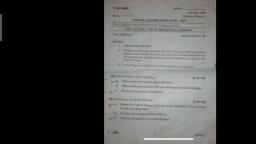Question 6 :
The enzyme that hydrolyses casein of milk into par casein is:
Question 7 :
Dihydroxy acetone ( <img style='object-fit:contain' src="https://storage.googleapis.com/teachmint/question_assets/NEET/5ead5cb56694ca4eac0fc338"> ) has the general formula of carbohydrate but not included in this class because:
Question 13 :
The enzyme which hydrolysis triglycerides to fatty acids and glycerol is called
Question 16 :
How many hydrogen bonds are present between pair of thymine and adenine in DNA?
Question 17 :
The pH value of a solution in which a polar amino acid does not migrate under the influence of electric field is called:
Question 22 :
Which of the following elements is responsible for oxidation of water to <img style='object-fit:contain' src="https://storage.googleapis.com/teachmint/question_assets/NEET/5ead5cbd41e6ca41178183cc"> in biological processes?
Question 27 :
The energy change produced by the combustion of foods is called the calorific value. The best calorific value is given by:
Question 31 :
Assertion: D-Fructose is used for sweetening cold drinks but not in hot ones
Reason: The sweet form is fructopyranose; on increasing temperature causes a shift in the pyranose $\rightleftharpoons $ furanose equilibrium towards the less sweet furanose form
Question 33 :
Glucose, when heated with $CH_{3}OH$, in presence of dry $HCl$ gas, $\alpha-$methyl glucosides and $\beta-$methyl glucosides are formed. This is because it contains:<br>
Question 34 :
State whether the following statements are True or False: <br>Epimers are a pair of diastereomers that differ only in the configuration about a single carbon atom.<br>
Question 35 :
During acetylation of glucose it needs $x$ moles of acetic anhydride. The value of $x$ would be:
Question 36 :
$0.44 g$ of a monohydric alcohol when added to methylmagnesium iodide in ether liberates $112\ { cm }^{ 3 }$ of methane at STP. With PCC, the same alcohol forms a carbonyl compound that undergoes a silver mirror test. The monohydric alcohol is :<br/>
Question 39 :
Which of the following compounds can be detected by Molisch's test?
Question 40 :
Match the sugars in column I with their types given in column II and mark the appropriate choice.<br><table class="wysiwyg-table"><tbody><tr><td>Column I</td><td>Column II</td></tr><tr><td>(A) Glucose</td><td>(i) Ketohexose</td></tr><tr><td>(B) Fructose</td><td>(ii) Aldohexose</td></tr><tr><td>(C) Ribose</td><td>(iii) Aldotetrose</td></tr><tr><td>(D) Erythrose</td><td>(iv) Aldopentose</td></tr></tbody></table>
Question 41 :
Which one of the following is the reagent used to identify glucose.
Question 42 :
What percentage of $\beta - D - (+) -$ glucopyranose is found at equilibrium in the aqueous solution?
Question 43 :
Ammonia is always is added in this reaction. Which ofthe following must be incorrect?<br>
Question 44 :
Statement- I : HCHO and HCOOH can be distinguished by Tollens test.<br/>Statement-II: Silver mirror is formed when ammonical $AgNO_{3}$ is reduced.<br/><br/>
Question 45 :
Assertion: Fructose is a reducing sugar.
Reason: Fructose has a ketonic group.
Question 47 :
The change is optical rotation with time of freshly prepared solutions of sugar, is known as
Question 48 :
Sugar in urine sample can be detected by:<br/>I : Fehling's solution<br/>II : Benedict's solution<br/>III : Tollen's solution<br/>Select the correct alternative.
Question 49 :
Formation of silver mirror by glucose shows that it is a/an
Question 50 :
$A, B$ and $C$ are three biomolecules. The results of the tests performed on them are given below :<br><table class="wysiwyg-table"><tbody><tr><td></td><td>Molisch's Test</td><td>Barfoed Test</td><td>Biuret Test</td></tr><tr><td>$A$</td><td>Positive</td><td>Negative</td><td>Negative</td></tr><tr><td>$B$</td><td>Positive</td><td>Positive</td><td>Negative</td></tr><tr><td>$C$</td><td>Negative </td><td>Negative</td><td>Positive</td></tr></tbody></table>$A, B$ and $C$ are respectively :<br>








































